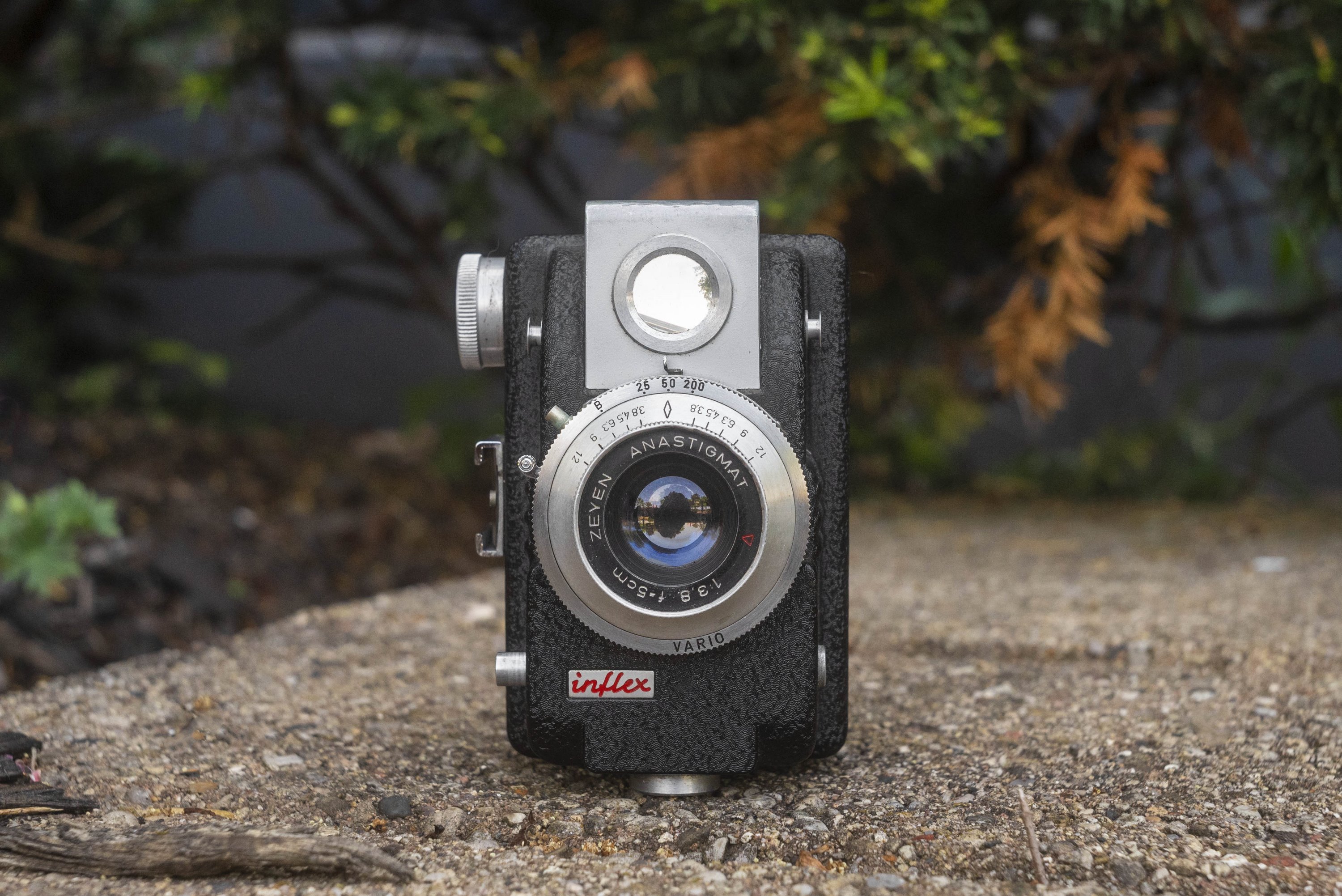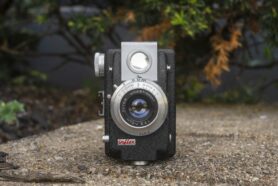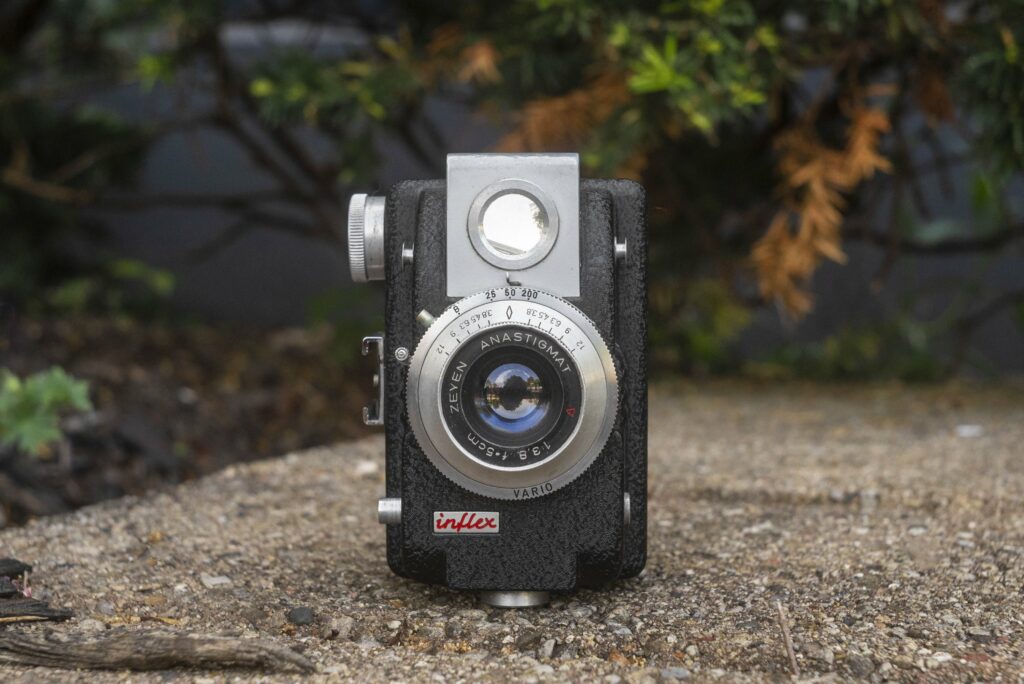This is an Inflex, a compact twin lens box camera produced by Paul Vieth AG in Solingen, West Germany around 1950. The Inflex produces twelve 4cm x 4cm images on a roll of 127 format film. The Inflex has a crackle paint finish Bakelite body with mostly metal controls and a large and bright reflex viewfinder. It is unusual in that it has a fairly advanced lens and shutter for a camera of this type. Most cameras of the twin lens box type usually have fixed focus meniscus or doublet lenses with simple one or two speed shutters. The Inflex has a full focusing coated Zeyen Anastigmat triplet and a three speed plus Bulb flash synchronized Vario leaf shutter.
Film Type: 127 Roll Film (twelve 4 cm x 4 cm exposures per roll)
Lens: 5 cm f/3.8 Zeyen Anastigmat coated 3-elements
Focus: 1 meter to Infinity
Viewfinder: Waist Level Brilliant Reflex Viewfinder
Shutter: Vario Leaf
Speeds: B, 1/25 – 1/200 seconds
Exposure Meter: None
Battery: None
Flash Mount: Cold shoe with PC Flash Sync Port
Other Features: None
Weight: 258 grams
Manual: None
How these ratings work |
The Inflex is a very interesting and uncommon camera that combines the simplicity of a twin lens box camera with an entirely metal body, large reflex viewfinder, three speed leaf shutter, and a capable lens. This combination of features, looks, and performance is almost as rare as the camera, but for those lucky enough to have one, make for an excellent shooter. The camera’s compact size make it unobtrusive and easy to carry, and although the images won’t rival a true TLR, they’re above that of just another simple box camera. | ||||||
| Images | Handling | Features | Viewfinder | Feel & Beauty | History | Age | |
| 1 | 2 | 1 | 1 | 2 | 1 | 30% | |
| Bonus | none | ||||||
| Final Score | 10.4 | ||||||
History
The Inflex is one of those cameras that came and went without many people noticing. This was a low production camera by a company not known to have made cameras. Very few of them were produced and even fewer survive to this day. In addition to its rarity, information about it is just as rare. Using all of the resources I have at my disposal, I was unable to find much information about it.
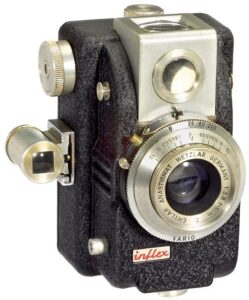
Information for the camera exists in two places, Jim McKeown’s price guide to cameras, and in a camera-wiki page for the camera. Both describe the camera as simply as I have in the intro to this article, with the camera-wiki page suggesting that a version of the camera found with a 5cm f/3.8 Emylar Anastigmat Wetlzar lens was also available. A Google search for “paul vieth inflex emylar” produces a Liveauctioneers page showing such a camera.
A third image on Flickr with no description shows an image of an Inflex with a Zeyer Anastigmat Wetzlar lens. Whether the three lenses are the same lens with three different names or truly three different designs, is unknown.
The camera-wiki article also differs in that it suggests the camera was produced in 1955 rather than 1950 as McKeown suggests. A footnote for this information is credited to an eBay auction from December 2014 which no longer exists. Whether or not this is true, I cannot say as eBay listings are hardly good resources for factual information, so for now, I’ll have to agree with Jim McKeown. If I ever find anything more conclusive, I’ll be sure to update this article.
And that’s it! While I generally pride myself in being able to dig up a lot of great historical information about even the least desirable cameras, the Paul Vieth Inflex is one that there just simply doesn’t appear to be much information out there. If anyone reading this article knows something about the company history, please let me know either through the Comments section below, or by using the Contact form on this site!
My Thoughts
There are simple cameras, there are advanced cameras, and there are cameras in between. Of all the “in between” cameras, most fall into one of a few groups. Those which still produce good results, and those which produce something less.
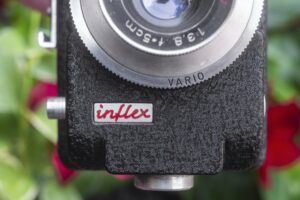
A huge number of single speed, fixed focus, single element lens cameras were produced throughout the 20th century. Whether you’re talking about a carboard Kodak Brownie from the early 20th century to a focus free “plastic fantastic” point and shoot from the 1980s, there are a huge number of cameras in his segment.
But what would you think about a simple box camera made mostly out of plastic, but with a pretty good three element lens and a proper leaf shutter with speeds from 1/25 to 1/200? If you are struggling to come up with a camera that fits that description, don’t feel bad, as before I had heard of the Inflex, I wouldn’t have been able to come up with one either.
Enter the Paul Vieth Inflex, a camera as obscure as its feature setup. This is an attractive mid century plastic and metal bodied camera with crinkle paint finish and metal accents that features an unusually good lens and shutter for its design. The camera is quite small and fits nicely into the palm of your hand, and with a weight of only 258 grams, is very comfortable to carry around with you.
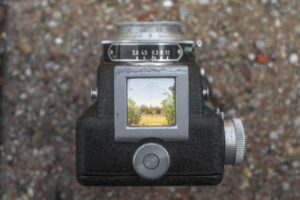
With the exception of the shutter, the controls on the body of the camera are sparse. Up top is the large, but not life size, square reflex viewfinder. Although somewhat resembling a Twin Lens Reflex, the Inflex is what I call a “twin lens box camera” as the viewfinder lens is not coupled to the taking lens and cannot show a focused image. What you get is similar to an Argus Seventy Five or Ensign Ful-Vue in which the reflected image is very bright and easy to see, but only an approximation of what the taking lens will capture. You are still in charge of guessing focus distance and manually corrected for parallax.
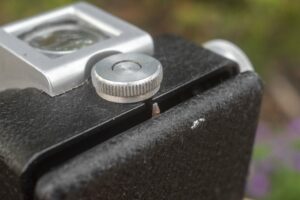
Immediately behind the viewfinder is a round knob which is used to lock the film compartment. A small pin that sticks up from the top edge of the door gets trapped under this threaded knob, holding it shut. When you unscrew the knob, it releases the pin, allowing the door to swing open. It is a rather crude type of door lock, but seems to work well.

The base of the camera has a 1/4″ tripod socket on a raised pedestal, which allows the camera to sit on a flat surface without tipping over. Normally, tripod sockets aren’t needed on simple box cameras as they usually lack a Bulb mode for the shutter, but on the Inflex, it could come in handy.
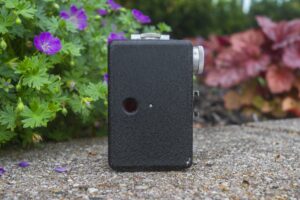
Around back, the Inflex has a round red peep hole for reading the exposure numbers off the film’s backing paper. There is no metal door to block excess light from passing through the window, so if you are using films faster than ASA 100 in the camera, I would advice blocking the window from direct sunlight.

Both sides of the camera have a metal lug for connecting a neck strap which is another uncommon box camera feature as most box cameras are so light and compact that a neck strap is not needed, but I appreciate its inclusion here.
The camera’s right side has a few more controls. From top to bottom is the film advance knob, accessory shoe, and cable threaded shutter release button. Since the Inflex is a roll film camera, film transports only in one direction, so there is no need for a rewind knob. The inclusion of a threaded shutter release button is also useful when paired with the tripod socket and Bulb exposures. The location of the shutter release is surprisingly handy, as when you support the bottom of the camera with your left hand, the shutter release falls nicely where your left index finger would normally rest. This makes holding and shooting the camera very comfortable and intuitive. Unscrewing the round knob behind the viewfinder at the top of the camera allows the bottom hinged film door to open. Inside the camera is mostly hollow, with the vertical film compartment transporting film from the bottom to the top.

As with all roll film cameras, you’ll need an empty spool from a previous roll of 127 film in the top compartment with a fresh supply loaded at the bottom. Thread the leader across the film gate and close the door. Inside the door is an unpainted metal pressure plate with a hole through it to read the exposure numbers. The door channels are deep, so no light seal material was needed when the camera was new. I always have my doubts about cameras like this without any seals. I would be careful to protect the seams from light the first time you shoot this camera to make sure there are no leaks.

Looking down upon the top of the shutter we see normal leaf shutter controls. The Vario was made by Gauthier who also made the Prontor and is in many ways an economy version of the Prontor. Its control layout is very similar, just with less settings. The three speed shutter has engraved markings for 25, 50, and 200. Strangely 100 is not indicated, but I believe that the shutter is infinitely variable, so putting the ring halfway between 50 and 200 should get you approximately that speed. Then again, who knows how accurate this shutter is anyway.

The diaphragm is controlled via a small chrome lever closest to the body. A curved metal plate with f/stops from f/3.8 to f/12 are indicated. Why the minimum aperture is f/12 and not something smaller is unknown. Looking at the diaphragm through the back of the lens as I operate the lever, it looks to me as if there is still room for the iris to close down to at least f/16 or even f/22, but for reasons that likely no one will ever know, the designers of this camera limited it to f/12.
From the front of the camera, looking at the left side of the shutter is the cocking lever. Press down on this lever to set the shutter and the threaded shutter release button to fire it. The Inflex lacks any sort of double exposure prevention, so you must take care to remember to advance your film immediately after each exposure so as not to double expose. Above the cocking lever is the flash sync port. As with most leaf shutters, the flash is synchronized at all speeds.
Beyond that, there’s nothing else to see here. As promised, this is a simple box camera with a not-so-simple leaf shutter and decent lens. Perhaps my favorite feature of the camera is how well it works together. The small size, light weight, and good ergonomics suggest a fun and easy shooting experience. But is it? Keep reading…
My Results
When I received the camera, included with it was a roll of hand cut and rolled Kodak Portra 160 on a 127 roll. Although I had no idea of what the film’s original expiration date was, or how it had been stored, I’ve often had good luck with expired Portra 160, so I figured I would give it a go in the Inflex. To give the old film a little bit of help, I shot it as if it was an ASA100 speed film. Since the camera lacks a 1/100 shutter speed, I set the shutter to 1/50 and subtracted one stop from whatever Sunny 16 would suggest.
There is always a risk when shooting expired film, especially color film. The exact age, type of film, and how it was stored all have dramatic effects on the quality of the photosensitive chemicals that make up the image. Having two identical film stocks stored identically for identical lengths of time don’t guarantee that both rolls will get you identical results. The results you’ll get from these films vary wildly and are part of the thrill of shooting expired film, but if unpredictable images give you the chills, it is something you might want to avoid.
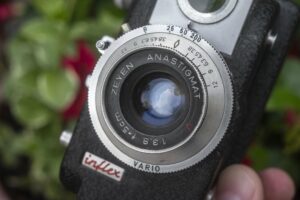
In the case of the roll of expired and cut down Kodak Portra 160, the results were on the lackluster side. Although I feel as though a good amount of detail was captured on the film, a very heavy amount of base fog resulted in very dark negatives. These dark negatives made my scanner work extra hard to extract what information it could from the images, resulting in streaks, pronounced grain, muted colors, and a loss of light sensitivity. All 12 images from that roll are presented in the gallery above and all but the mirror selfie show a usable amount of detail. In the case of my usual mirror image, I had to push the exposure settings in post processing to the max to get what I got. It doesn’t look great, but that’s OK.
It is not all bad though, looking at the images, I can clearly see images with good sharpness in the center and predictable softness near the corners. While this quality of image is very typical of similar twin lens box cameras, I was actually a bit disappointed that the images weren’t better. I have no experience with Zeyen lenses, but I would have thought that a coated triplet would have been able to cover a 4cm x 4cm image better.
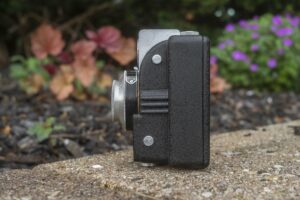
Softness and vignetting are very strong in outdoor images where I would have stopped down the lens. Apart from my mirror selfie, I did not attempt to take an indoor shots, but I suspect the vignetting would be minimized with the diaphragm open all way. Still, sharpness is good, and I do believe that with fresh 127 film, the images would have delighted the original owners of these cameras. To expect corner to corner sharpness with no optical anomalies was not realistic in this segment, no matter what lens or shutter it had.
Using the camera, I very much appreciated its compact size and good ergonomics of the shutter release. The compact size of the Inflex allows it to rest comfortably in the palm of my left hand with my left index finger resting on the shutter release. I used my right hand to focus the lens and advance the film, but otherwise can be used one handed. The camera does have strap lugs, although I did not use a strap, but had I used one, the light weight of the camera would have meant it could hang from my neck on a hike or trip with the family to the zoo, further adding to the appeal of this camera.
It is difficult to come up with real complaints about cameras like this as these were simple and expensive cameras in which expectations should be tempered. For what it is, I was very happy with the use and results of the Infex. I wish I could find more information about who Paul Vieth was, and it is too bad that this wasn’t a more well known camera as I quite liked it. It is well built, and attractive, and although not something that you will easily find for sale today, if you happen to come across one, I doubt you’d be unhappy to add it to your collection!
Related Posts You Might Enjoy
External Links
http://camera-wiki.org/wiki/Inflex
http://archiv.club-daguerre.de/inflex.htm (in German)

